Puff Daddy (Further Fungal Forays)
By Ruth D’Alessandro, The Wildlife Gardener The damp autumn has brought with it a further craving for wild mushrooms. The Boletus mushrooms were just a tantalising starter. And the Wildlife Gardener has found a kindred foraging spirit: the wonderful Mary who lives just down the road and is a wildlife gardener herself.

Most folk of Mary’s vintage have resigned themselves to wingback chairs. Mary, however, would rather be digging her organic veg patch, baking organic bread, campaigning against poverty and injustice in the world, and hiking up the downs to forage for mushrooms. Mary is an inspiration, and a comforting mushrooming companion: she has been eating wild mushrooms for many decades and is in rude health, so she knows what she’s doing. So on a grey drizzly day (perfect mushrooming weather) Mary and I set off in boots and waterproofs to pastures and woodland margins on the North Downs. We walked through herds of little black bulls and big brown steers that sniffed us curiously. By a bizarre coincidence, Mary studied dairying in Reading during the war and I grew up playing among Reading University’s dairy herds. So both of us understand cattle enough to be able to walk among them safely. Mary had seen parasol mushrooms in a field just over the M25, but the cattle had trampled them down. All we found were some shaggy ink caps (Coprinus comatus):
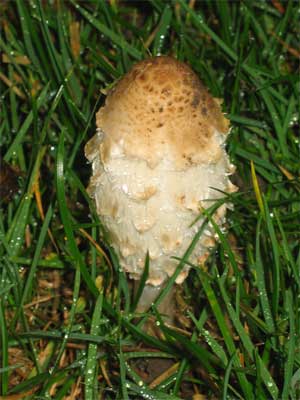
Edible, but turning poisonous if you consume them with alcohol. Not really a candidate for a mushroom feast. If I’m cooking wild mushrooms I expect to have a glass of particularly good wine with them! The next field was full of nettle patches and edged with woodland. We could see a glowing white thing in the far corner that looked promising. Mary had found shaggy parasol mushrooms (Macrolepiota rhacodes) there the week before, but they were by now full of little worms and inedible.
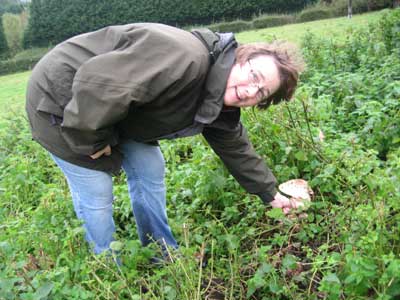
The prize, however, was a giant puffball, the glowing white thing that we saw from afar. Puffballs (Calvatia gigantea) love pastureland, nettles and manure heaps. They start off life as little white balls, growing steadily, until they mature, turn green and crackly and produce millions of powdery spores. There were lots of mature green puffballs around so Mary and I gave them a good beating to disperse the spores. We felt we owed the species one. As we carried off our prize we followed the woodland edge, and found a second delicacy ” another boletus! This time it had a red stalk! Could this be the rare Devil’s bolete (Boletus satanas)? In a delightful twist, after I had posted the Bol-eat-us article, The Ranger e-mailed me:
I’d never heard of Satan’s Bolete until you wrote about it. Nor did I ever expect to again. But within 24 hours, sitting in a team meeting, what did our ecologist produce from a plastic bag but a massive (25cm diameter) specimen of said mushroom, rediscovered at one of our nature reserves having been thought to be extinct on the Island. So of course I was able to pretend I knew all about it.
So had Mary and I found another one? We took it home to find out. We laid out our morning’s treasures on a tray:

We cut the boletus in half and it turned blue. A red stalked toadstool that turns blue. That can’t be harmless, surely? But, consulting several books, including John Wright’s excellent Mushrooms ” River Cottage Handbook no. 1 we identified it as an edible Scarletina Boletus (Boletus luridiformis), different from the Devil’s Boletus because it had a velvety brown cap instead of a dusty white one. The Scarletina Bolete must be cooked, though. It is poisonous raw. We weighed the puffball ” 1.4kg!
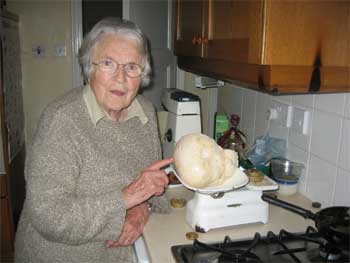
Mary set about cooking up our finds ” half the puffball, one non-wormy parasol mushroom and That Boletus.
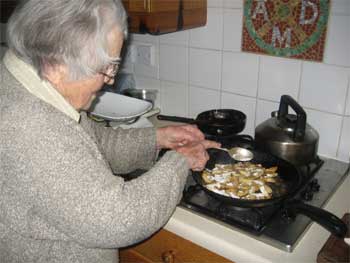
This is her recipe:
- Melt lots of butter in a frying pan.
- Peel the puffball, cut it into 1cm slices and break into pieces.
- Wash and slice any other mushrooms.
- Fry them until golden and any water has boiled off.
- Add a good sprinkling of salt. Wild mushrooms need salt ” they are quite insipid without.
- Sprinkle on some flour, stir in well and ‘cook out’ slightly, then mix in some milk to make a sauce.
- Add lots of black pepper and the juice of half a lemon.
- Make toast. Pour the mushrooms onto the toast.
- Eat.
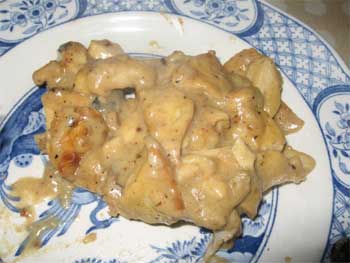
We ate wild mushrooms (the boletus, half each, was exquisite), drank Mary’s home-made elderflower cordial, and finished off with home-grown pears while discussing the state of the world. And again, I’m here to tell the tale this morning, as is Mary, ready to forage another day!
IMPORTANT NOTE If you are going to pick wild mushrooms to eat you MUST get at least two good books on the subject and double check and cross-refer furiously before eating a mushroom. If in any doubt, DON’T! Better still, do as the Wildlife Gardener does and go picking with somebody who knows what they are doing.
- Spurn Spawn! - 26th February, 2014
- Bluebells on wheels: axles of evil? - 2nd February, 2011
- Raising the ba: Wildlife and the Ancient Egyptian Book of the Dead - 8th January, 2011

Thanks for the advice, Katy! I’ve found enough wood blewits, hedgehog mushrooms, chanterelles and ceps not to worry about picking and eating ink caps this year!
Hi, just so you don’t deprive yourself anymore, you can drink alcohol with shaggy ink caps! It’s the common ink cap that you have to avoid drinking on : )
Thank YOU!
I have been talking with “so called” experts about the mushroom I have here. (in Arizona, USA)
The “expet” said I have a “dead mans foot”.
Ya know? I never did agree with his opinion!
It’s a shaggy mane. (USA)
Go get ’em Mary!!
You are an inspiration yo us all..:)
have never picked mushrooms before – too scared – but want to learn. can you supply names of people/organisations who go foraging in the north hampshire region?
many thanks
Jackie
The Ranger responds: I’m not a Hampshire ranger so I don’t know any myself, but try the Hampshire Fungus Recording Group.
Hi Sam, Puffballs are a fairly forgiving mushroom to cook, but best fried so that they brown slightly. If you put them straight into stews and sauces they go a bit slimy. And despite government health warnings, you do need to season robustly with salt. I leave the cooking to my senior expert!
Bridget plays in a band with my mum and we had a look and it looks like something I would really like to try sometime, but id have to get someone to cook it for me, i can imagine it not being so nice if it was unproperly cooked! I hope i can cook it for myself though at 84!
That looks like some breakfast! I’d better start now to have the confidence to go foraging when I’m 84!
I found you in Brit Blog but got a 403 spammer message – don’t know if you are aware of that.
That is what I like to see, ladies that do not give in to the lure of winback chairs!
The Ranger responds: sorry about the antispam and thanks for persisting – I’ve turned it down a couple of notches and it should now work fine from that site.
What an inspirational 84 year old…keep it up!!